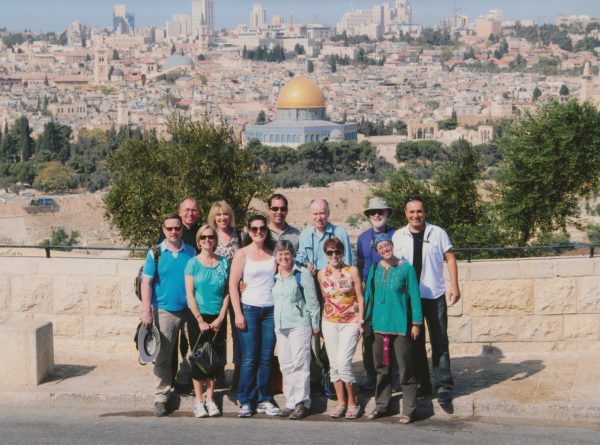You also, like living stones, are being built into a spiritual house. –1 Peter 2:4
This photograph shows the small group of friends with whom I toured Israel in October 2012.
Why is this picture in this book? First of all, because this book is dedicated to these friends; their names are listed at the front. And secondly, because these people, like all the other stones in this book, fit the category of stones known and touched by Jesus. As Peter says, they are “living stones.”
Peter should know, because his name, the name Jesus gave him, means stone or rock. No wonder Peter was so interested in this topic that he devoted five long verses in his first epistle to explicating the central meaning of stone imagery in the Bible. Citing three passages from the Old Testament, he shows how Jesus Christ is the “cornerstone” of the “spiritual house” that God has been building all along. Paul employs this same image in Ephesians, describing the raising of a new temple made of believers who are like stones “being built together into a dwelling place for God by the Spirit” (vv 20-22).
The phrase “living stones” is an oxymoron: Is anything more lifeless than a rock? Yet God can do the impossible, bringing life out of death, something out of nothing, streams of living water from hard rock. Through the power of the gospel, souls who were little better than stones, “dead in transgressions,” are made “alive with Christ” (Eph 2:5) and joined together into a living temple. And thus is fulfilled the ancient promise that God would have a place of residence on earth. As Jesus was a carpenter, so He is a stonemason, crafting and hewing each one of us into precisely the right shape to be fitted into heavenly homes.
On my tour of Israel our group said the following prayer every day: “Lord Jesus Christ, You were a pilgrim in the Holy Land. Now You lead and guide us on our pilgrimage to the heavenly Jerusalem. As we follow in Your steps, we ask the grace to keep our eyes on You. Open our hearts that we may find You not only in ancient stones, but in Your people and in each other.”
Through a curious twist of destiny, I happen to live in a community called Livingstone Ridge, which began as a Christian housing co-operative. A group of us sold our detached homes and with the proceeds built a townhouse complex, designating several units for low-income housing. We thought of this downsizing as “a privilege, not a sacrifice” (our motto), and over twenty years later my wife and I remain grateful residents of this unique community.
In the early chapters of the book of Revelation, certain gifts are promised to those who overcome by listening to the Spirit. One of these gifts is “a white stone with a new name written on it, known only to him who receives it” (2:17). I’ve always pictured this stone as a small roundish pebble that I could put in my pocket. But now I think not. What I see now is a block too heavy for me to lift, a squared chunk of white Jerusalem rock ready to be fitted into a wall, a stone that derives meaning only from being placed alongside many others.
Next Post: Epilogue

